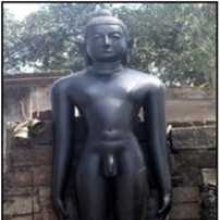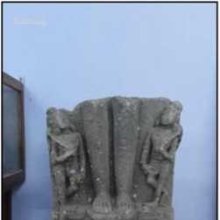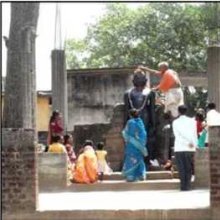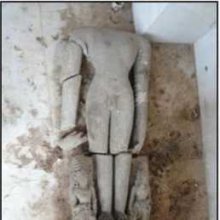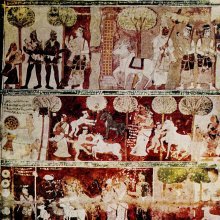Neminatha, Neminātha, Nemi-natha: 6 definitions
Introduction:
Neminatha means something in Jainism, Prakrit, Hinduism, Sanskrit, the history of ancient India. If you want to know the exact meaning, history, etymology or English translation of this term then check out the descriptions on this page. Add your comment or reference to a book if you want to contribute to this summary article.
Images (photo gallery)
(+1 more images available)
In Jainism
General definition (in Jainism)
Source: Wisdom Library: JainismNeminātha (नेमिनाथ) is another name for Nemin, the twenty-second Tīrthaṅkara (Janism recognizes 24 such teachers or Siddhas). His colour is black (śyāma), according to Aparājitapṛcchā (221.5-7). His height is 15 dhanuṣa (a single dhanuṣa (or, ‘bow’) equals 6 ft), thus, roughly corresponding to 18 meters. His emblem, or symbol, is a Śaṅkha.
Neminātha’s father is Samudravijaya and his mother is Śivādevī. It is an ancient Jain practice to worship the Tīrthaṅkara’s parents in various rites, such as the pratiṣṭhāvidhi, according to the Ācāradinakara (14th work on Jain conduct written by Vardhamāna Sūri).
Source: archive.org: The Jaina Iconography
Neminātha (नेमिनाथ) refers to the twenty-second of twenty-four Tīrthaṃkaras or Jinas, commonly depicted in Jaina iconography.—Neminātha’s emblem is known to be a conch-shell from the Jaina canonical texts. The Śāsana-devatās who attend upon him are Yakṣa Gomedha and Yakṣiṇī Ambikā (Digambara: and Kuṣmāṇḍinī). The Chowri-bearer, in his case, is King Ugrasena. His Kevala-tree is called Mahāveṇu or Vetasa.
The Jina’s parentage and family have a well-known historical background according to the Jainas. His father was named Samudravijaya. He was the king of Sauripurī or Dvārakā. His race is known as Harivaṃśa, Neminātha’s mother’s name was Śivadevī. The most interesting point in this connection is that Neminātha was a cousin of Śrī Kṛṣṇa and Baladeva. His name has been derived in two ways. First, his circumference (figuratively) was like that of the Dharma Cakra. Secondly, before his birth his mother saw a wheel of black jewels. Hence, his other name of Ariṣṭanemi. His emblem of a conch may be accounted for as being symbolic of his residence in a sea-side place where conches area bundantly met with or as reminiscent of his kinship with the Vaiṣṇavite family of Śrīkṛṣṇa.

Jainism is an Indian religion of Dharma whose doctrine revolves around harmlessness (ahimsa) towards every living being. The two major branches (Digambara and Svetambara) of Jainism stimulate self-control (or, shramana, ‘self-reliance’) and spiritual development through a path of peace for the soul to progess to the ultimate goal.
India history and geography
Source: archive.org: Social Life In Medieval RajasthanNeminātha temple in Rājasthān.—It has been known through an inscription that in 1031 A.D., during the reign of Bhima, Vardhmān Suri of Gujarāt consecrated the famous temple of Nemināth (Neminātha) on Mt. Abu. In V.S. 1473 (1416 A.D.)

The history of India traces the identification of countries, villages, towns and other regions of India, as well as mythology, zoology, royal dynasties, rulers, tribes, local festivities and traditions and regional languages. Ancient India enjoyed religious freedom and encourages the path of Dharma, a concept common to Buddhism, Hinduism, and Jainism.
Languages of India and abroad
Sanskrit dictionary
Source: Cologne Digital Sanskrit Dictionaries: Monier-Williams Sanskrit-English DictionaryNeminātha (नेमिनाथ):—[=nemi-nātha] [from nemi] m. Name of a man, [Horace H. Wilson]
[Sanskrit to German]
Sanskrit, also spelled संस्कृतम् (saṃskṛtam), is an ancient language of India commonly seen as the grandmother of the Indo-European language family (even English!). Closely allied with Prakrit and Pali, Sanskrit is more exhaustive in both grammar and terms and has the most extensive collection of literature in the world, greatly surpassing its sister-languages Greek and Latin.
See also (Relevant definitions)
Starts with: Neminatan, Neminatharasa, Neminathavivahalo.
Full-text (+32): Shivadevi, Samudravijaya, Kushmandini, Kuna-virapantitar, Nalakacchapura, Ambika, Kushmandi, Amra, Arishtanemi, Gomedha, Nemanathastavana, Vetasa, Mahavenu, Gomeda, Ugrasena, Premaraja, Harivamsha, Vedabhivivaha, Vedabhi, Vasudeva.
Relevant text
Search found 13 books and stories containing Neminatha, Neminātha, Nemi-natha, Nemi-nātha; (plurals include: Neminathas, Nemināthas, nathas, nāthas). You can also click to the full overview containing English textual excerpts. Below are direct links for the most relevant articles:
Jainism in Odisha (Orissa) (by Ashis Ranjan Sahoo)
Ambika images (Koraput) < [Chapter 3: Survey of Jaina Antiquities in Odisha]
Jaina Sculptures of Odisha in Foreign Museums < [Chapter 3: Survey of Jaina Antiquities in Odisha]
Jaina Sculptures at Achutrajpur < [Chapter 3: Survey of Jaina Antiquities in Odisha]
Jain Remains of Ancient Bengal (by Shubha Majumder)
Images of Tīrthaṅkara Neminātha < [Chapter 6 - Iconographic Study of Jaina Sculptural Remains]
Historical development of Jainism (Introduction) < [Chapter 3 - Historical Background of Jainism in Ancient Bengal]
Jain images from Ancient Bengal (Introduction) < [Chapter 6 - Iconographic Study of Jaina Sculptural Remains]
Mount Abu < [October 1956]
Trishashti Shalaka Purusha Caritra (by Helen M. Johnson)
Introduction to volume 5 < [Introductions]
Part 1: Invocation < [Chapter I - Brahmadattacaritra]
Part 5: Episode of Rathamemi and Rājīmatī < [Chapter IX - Ariṣṭanemi’s sport, initiation, omniscience]
Sripura (Archaeological Survey) (by Bikash Chandra Pradhan)
Jaina Vihara < [Chapter 2 - The Architectural Panorama]
Buddhist records of the Western world (Xuanzang) (by Samuel Beal)
Chapter 10 - Country of Su-la-ch’a (Surashtra) < [Book XI - Twenty-three Countries]
